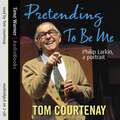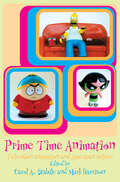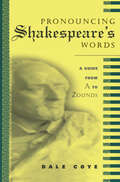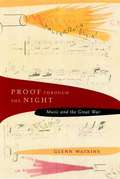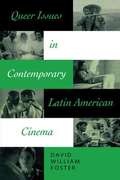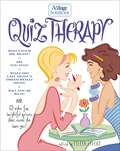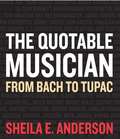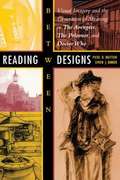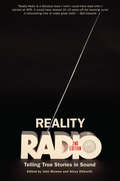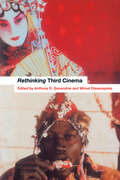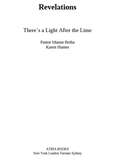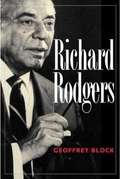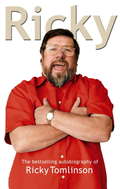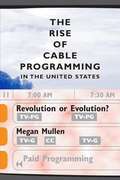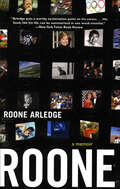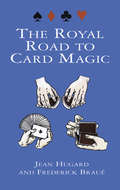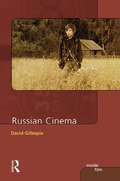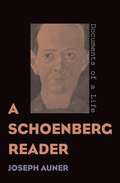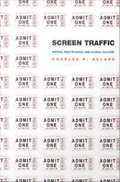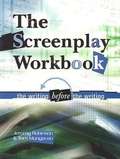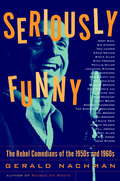- Table View
- List View
Pretending To Be Me: Philip Larkin, A Portrait
by Tom CourtenayPRETENDING TO BE ME is an intimate, acerbic and occasionally scurrilous show about the poet, jazz aficionado and Hull University librarian, Philip Larkin.Larkin ('the magnificent Eeyore of British verse' - Daily Telegraph) has moved home; surrounded by packing cases, playing selections from his favourite jazz LPs, and making himself cups of tea - and later whiskies - he reflects wryly on writing and life.Hilarious and moving, the narrative shifts seamlessly between Larkin's outrageous wit and the poems, which Courtenay reads with powerful directness and simplicity.PHILIP LARKIN, one of the foremost figures in 20th-Century English poetry, feared his epitaph would be: 'They fuck you up, your mum and dad'. This, and other familiar poems, 'An Arundel Tomb', 'The Whitsun Weddings' and 'High Windows' are included in PRETENDING TO BE ME.
Prime Time Animation: Television Animation and American Culture
by Carol StabileIn September 1960 a television show emerged from the mists of prehistoric time to take its place as the mother of all animated sitcoms. The Flintstones spawned dozens of imitations, just as, two decades later, The Simpsons sparked a renaissance of primetime animation. This fascinating book explores the landscape of television animation, from Bedrock to Springfield, and beyond.The contributors critically examine the key issues and questions, including: How do we explain the animation explosion of the 1960s? Why did it take nearly twenty years following the cancellation of The Flintstones for animation to find its feet again as primetime fare? In addressing these questions, as well as many others, essays examine the relation between earlier, made-for-cinema animated production (such as the Warner Looney Toons shorts) and television-based animation; the role of animation in the economies of broadcast and cable television; and the links between animation production and brand image. Contributors also examine specific programmes like The Powerpuff Girls, Daria, Ren and Stimpy and South Park from the perspective of fans, exploring fan cybercommunities, investigating how ideas of 'class' and 'taste' apply to recent TV animation, and addressing themes such as irony, alienation, and representations of the family.
Pronouncing Shakespeare's Words: A Guide From A To Zounds
by Dale CoyeFirst published in 2003. Routledge is an imprint of Taylor & Francis, an informa company.
Proof through the Night: Music and the Great War
by Glenn WatkinsWatkins investigates the variable roles of music primarily from the angle of the Entente nations' perceived threat of German hegemony in matters of intellectual and artistic accomplishment--a principal concern not only for Europe but also for the United States, whose late entrance into the fray prompted a renewed interest in defining America as an emergent world power as well as a fledgling musical culture.
Queer Issues in Contemporary Latin American Cinema
by David William FosterViewing contemporary Latin American films through the lens of queer studies reveals that many filmmakers are exploring issues of gender identity and sexual difference, as well as the homophobia that attempts to defeat any challenge to the heterosexual norms of patriarchal culture.<P><P> In this study of queer issues in Latin American cinema, David William Foster offers highly perceptive queer readings of fourteen key films to demonstrate how these cultural products promote the principles of an antiheterosexist stance while they simultaneously disclose how homophobia enforces the norms of heterosexuality. <P> Foster examines each film in terms of the ideology of its narrative discourse, whether homoerotic desire or a critique of patriarchal heterosexism and its implications for Latin American social life and human rights. His analyses underscore the difficulties involved in constructing a coherent and convincing treatment of the complex issues involved in critiquing the patriarchy from perspectives associated with queer studies. The book will be essential reading for everyone working in queer studies and film studies.
Quiz Therapy: An iVillage Solutions Book
by Eileen LiversAre you in love with a leech? What did last night's dream really mean? Will you be rich? Are you sexy? For years, quizzes appearing online and in magazines have fascinated and captured the attention of women of all ages. People send online quizzes to their friends and compare scores. Couples and girlfriends take them together to better understand each other.Quiz Therapy: The iVillage Big Book of Quizzes will feature more than 65 quizzes in categories such as Personality, Love, Dating, Couples, Weddings, Home and Beauty. Each quiz is 2 to 3 pages and allows readers to tally their points and match their score against the point ranges for the result groupings.
The Quotable Musician: From Bach to Tupac
by Sheila E. AndersonFor those looking for a little more from musicians and composers than music here are quotations of wit and wisdom, anger and admission. Material is divided into 30 topics such as identity, humor, conducting, other musicians, wisdom, and society. Also featured are short interviews with Ron Carter, a discussion about Thelonious Sphere Monk with his son, and Benny Golson. Musicians and composers run the genre gamut, with jazz, classical, and popular musics featured most predominantly. Anderson is the host of Sunday Morning Harmony on WBGO in Newark. The book is geared to a popular readership. Annotation (c)2003 Book News, Inc. , Portland, OR (booknews. com)
Reading between Designs: Visual Imagery and the Generation of Meaning in The Avengers, The Prisoner, and Doctor Who
by Piers D. Britton Simon J. BarkerFrom the alien worlds of Star Trek to the realistic operating room of ER, the design of sets and costumes contributes not only to the look and mood of television shows, but even more importantly to the creation of memorable characters. Yet, until now, this crucial aspect of television creativity has received little critical attention, despite the ongoing interest in production design within the closely allied discipline of film studies.<P><P>In this book, Piers Britton and Simon Barker offer a first analytical study of scenic and costume design for television drama series. They focus on three enduringly popular series of the 1960s--The Avengers, The Prisoner, and Doctor Who--and discuss such topics as the sartorial image of Steed in The Avengers, the juxtaposition of picturesque and fascistic architecture in The Prisoner, and the evolution of the high-tech interior of Doctor Who's TARDIS. Interviews with the series' original designers and reproductions of their original drawings complement the authors' analysis, which sheds new light on a variety of issues, from the discourse of fashion to that of the heritage industry, notions of "Pop" and retro, and the cultural preoccupation with realism and virtual reality.
Reality Radio, Second Edition: Telling True Stories in Sound (Documentary Arts and Culture, Published in association with the Center for Documentary Studies at Duke University)
by John Biewen and Alexa DilworthThis new revised and expanded edition of Reality Radio celebrates today's best audio documentary work by bringing together some of the most influential and innovative practitioners from the United States, Canada, the United Kingdom, and Australia. With a new foreword and five new essays, this book takes stock of the transformations in radio documentary since the publication of the first edition: the ascendance of the podcast; greater cultural, racial, and topical variety; and the changing economics of radio itself. In twenty-four essays total, documentary artists tell--and demonstrate, through stories and transcripts--how they make radio the way they do, and why. Whether the contributors to the volume call themselves journalists, storytellers, or even audio artists--and although their essays are just as diverse in content and approach--all use sound to tell true stories, artfully. Contributors include Jad Abumrad, Daniel Alarcon, Jay Allison, damali ayo, John Biewen, Emily Botein, Chris Brookes, Scott Carrier, Katie Davis, Sherre DeLys, Ira Glass, Alan Hall, Dave Isay, Natalie Kestecher, Starlee Kine, The Kitchen Sisters, Sarah Koenig and Julie Snyder, Maria Martin, Karen Michel, Joe Richman, Dmae Roberts, Stephen Smith, Alix Spiegel, Sandy Tolan, and Glynn Washington.Jad Abumrad, RadiolabDaniel Alarcon, Radio AmbulanteJay Allison, The Moth Radio Hour, Transom.orgdamali ayo, independent audio producerJohn Biewen, audio program director at CDS, Scene on RadioEmily Botein, vice president of On-Demand Content, WNYCChris Brookes, independent audio producer, Battery RadioScott Carrier, This American Life, Home of the BraveKatie Davis, special projects coordinator at WAMU, Neighborhood StoriesSherre DeLys, 360documentaries, ABC Radio National Ira Glass, This American LifeAlan Hall, independent audio producer, Falling Tree ProductionsDave Isay, StoryCorpsNatalie Kestecher, Pocketdocs, ABC Radio NationalStarlee Kine, Mystery ShowThe Kitchen Sisters, The Hidden World of Girls, Hidden Kitchens Sarah Koenig and Julie Snyder, SerialMaria Martin, Latino USA, GraciasVida Center for MediaKaren Michel, independent audio producerJoe Richman, Radio DiariesDmae Roberts, independent audio producerStephen Smith, APM ReportsAlix Spiegel, InvisibiliaSandy Tolan, independent audio producer, Homelands ProductionsGlynn Washington, Snap Judgment
The Red and the Blacklist: The Intimate Memoir of a Hollywood Expatriate
by Norma BarzmanThe horrors of the McCarthy era.
Rethinking Third Cinema: The Role Of Anti-colonial Media And Aesthetics In Postmodernity (Kultur: Forschung Und Wissenschaft Ser. #13)
by Wimal Dissanayake Anthony R. GuneratneThis important anthology addresses established notions about Third Cinema theory, and the cinema practice of developing and postcolonial nations. The 'Third Cinema' movement called for a politicised film-making practice in Africa, Asia and Latin America, one which would take on board issues of race, class, religion, and national integrity. The films which resulted from the movement, from directors such as Ousmane Sembene, Satyajit Ray and Nelson Pereira dos Santos, are among the most culturally signficant, politically sophisticated and frequently studied films of the 1960s and 1970s. However, despite the contemporary popularity and critical attention enjoyed by films from Asia and Latin America in particular, Third Cinema and Third Cinema theory appears to have lost its momentum.Rethinking Third Cinema seeks to bring Third Cinema and Third Cinema theory back into the critical spotlight. The contributors address the most difficult and challenging questions Third Cinema poses, suggesting new methodologies and redirections of existing ones. Crucially, they also re-examine the entire phenomenon of film-making in a fast-vanishing 'Third World', with case studies of the cinemas of India, Iran and Hong Kong, among others.
Revealing Jewel: An Intimate Portrait from Family and Friends
by Cambria Jensen Kenneth CalhounA complete and revealing portrait of Jewel, of one of today's most multifaceted and talented performers, is drawn from over 30 celebrity interviews and a host of never-before-seen photos. 40 photos.
Revealing Jewel
by Atz Lee Kilcher Cambria Jensen Kenneth CalhounShe has been called "one of the most richly idiomatic female pop singers of her generation" by Rolling Stone magazine. Translation: Jewel speaks to millions of fans of all ages through her award-winning music and bestselling poetry books. Now, get to know this supertalented performer for the down-to-earth, savvy, and unpretentious person she is -- a dynamic young woman who, her friends all agree, is "too normal to be a rock star." Revealing Jewel pieces together a remarkable portrait, through the words of those who know her best: her family and close friends, her band, and her colleagues on the road, in the studio, and on the movie set -- including Moby, producer Arif Mardin, actor/director Billy Bob Thornton, Jewel's father, singer/ songwriter Atz Kilcher, and her mother and manager, Lenedra J. Carroll. This one-of-a-kind compilation gets up close and personal on: Jewel's childhood...the hard times...her rise to fame...paying her dues...the recording experience...the touring life...superstardom...artistic pursuits...her passions...her causes...her friendships...her love life...her personal style...her sharp wit and hard-won wisdom. Also included are trivia questions, candid photos, and sidebars in Jewel's own words. Delve into Revealing Jewel and celebrate the heart and soul of an artist who constantly challenges our assumptions and defies our expectations.
Revelations: There's a Light after the Lime
by Mason BethaImagine having it all and leaving it all behind -- to answer a higher calling... REVELATIONS His rise to fame was one of rap's great success stories. He had millions of fans and the prospect of multi-millions of dollars. But just as Mase -- as he was then called -- was poised to sign a deal with Sean "Puffy" Combs' famed Bad Boy Records, he walked away. Revelations is Mason Betha's powerful memoir about a miraculous transformation: his own -- from the material-minded Mase to the pastor he has become. Here, Betha reveals the rhyme and reason behind his choice to trade in his sensational music career for a richer, more spiritual one. As founder of a nondenominational movement called S.A.N.E. (Saving a Nation Endangered) Ministries, Betha has traveled throughout the country to share his messages of peace and prosperity with today's youth. Revelations is his testament to the enduring power of faith, and to the limitless possibilities in a life transformed by God's guiding hand.
Richard Rodgers
by Geoffrey BlockGeoffrey Block examines the entire range of Rodgers's work, providing rich details about the creation, staging, and critical reception of some of his most popular musicals.
Ricky: The Autobiography
by Ricky TomlinsonI know that I'm going to get stick over this book, but there you go - it can't be helped. And some readers might think I'm a terrible liar when they read what follows, but everything in this book is true. Enough lies have been told about me, without me adding to them.' Famous as the lovable couch potato Jim Royle of The Royle Family, Ricky Tomlinson has entertained millions without ever leaving his armchair. Now, in his long-awaited autobiography, he surprises yet again with a remarkable story of love, hardship, humour, injustice and triumph. His mother used to tell him that he had lived three lives, but even she miscounted. He has been a plasterer, banjo player, stand-up comic, union agitator, political activist, film extra, award-winning actor and unwilling guest of Her Majesty's prison service. Renowned and respected for his honesty, wit and integrity, Ricky brings all of these qualities to his extraordinary, moving and inspiring story.
Ricky
by Ricky TomlinsonI know that I'm going to get stick over this book, but there you go - it can't be helped. And some readers might think I'm a terrible liar when they read what follows, but everything in this book is true. Enough lies have been told about me, without me adding to them.' Famous as the lovable couch potato Jim Royle of The Royle Family, Ricky Tomlinson has entertained millions without ever leaving his armchair. Now, in his long-awaited autobiography, he surprises yet again with a remarkable story of love, hardship, humour, injustice and triumph. His mother used to tell him that he had lived three lives, but even she miscounted. He has been a plasterer, banjo player, stand-up comic, union agitator, political activist, film extra, award-winning actor and unwilling guest of Her Majesty's prison service. Renowned and respected for his honesty, wit and integrity, Ricky brings all of these qualities to his extraordinary, moving and inspiring story.
The Rise of Cable Programming in the United States: Revolution or Evolution?
by Megan MullenIn 1971, the Sloan Commission on Cable Communications likened the ongoing developments in cable television to the first uses of movable type and the invention of the telephone. <P><P>Cable's proponents in the late 1960s and early 1970s hoped it would eventually remedy all the perceived ills of broadcast television, including lowest-common-denominator programming, inability to serve the needs of local audiences, and failure to recognize the needs of cultural minorities. Yet a quarter century after the "blue sky" era, cable television programming closely resembled, and indeed depended upon, broadcast television programming. Whatever happened to the Sloan Commission's "revolution now in sight"?
Roone: A Memoir
by Roone ArledgeRoone Arledge's extraordinary career of more than a half century mirrors the history of the television industry he helped create. Roone is the vivid, intimate account of his own rise to fame and power as the head of both ABC Sports and ABC News as well as an up-close-and- personal story of his era, peopled with friends and foes alike.
The Royal Road to Card Magic (Dover Magic Bks.)
by Jean Hugard Frederick BrauéWould you like to confound your friends, amaze your acquaintances, amuse and dazzle crowds at parties and gatherings? Mastering a few card tricks will allow you to do all that and more. With the help of this book, anyone can develop a versatile repertoire of first-rate card tricks. In fact, mastery of just the first chapter will enable you to perform a half-dozen astounding and entertaining sleights of hand. The authors, both noted authorities on magic, present complete, easy-to-understand explanations of shuffles, flourishes, the glide, the glimpse, false shuffles and cuts, the pass, the classic force, and many other techniques. These will enable card handlers to perform over 100 mind-boggling feats of card magic, including Thought Stealer, Gray's Spelling Trick, Do as I Do, Now You See It, Obliging Aces, Rapid Transit, Kangaroo Card, A Tipsy Trick, and dozens of others. Illustrated with more than 120 clear line cuts that make the explanations easy to follow, this exciting introduction to card conjuring will enable even beginners to develop professional-level skill and the ability to perform tricks guaranteed to astound family and friends.
Russian Cinema (Inside Film)
by David C. GillespieRussian Cinema provides a lively and informative exploration of the film genres that developed during Russia's tumultuous history, with discussion of the work of Eisenstein, Pudovkin, Mikhalkov, Paradzhanov, Sokurov and others. The background section assesses the contribution of visual art and music, especially the work of the composers Shostakovich and Prokofev, to Russian cinema. Subsequent chapters explore a variety of topics: The literary space - the cinematic rendering of the literary text, from 'Sovietized' versions to bolder and more innovative interpretations, as well as adaptations of foreign classics The Russian film comedy looks at this perennially popular genre over the decades, from the 'domestication' of laughter under Stalin to the emergence of satire The historical film - how history has been used in film to affirm prevailing ideological norms, from October to Taurus Women and Russian film discusses some of the female stars of the Soviet screen (Liubov Orlova, Vera Alentova, Liudmila Gurchenko), as well as films made by male and female directors, such as Askoldov and Kira Muratova Film and ideology shows why ideology was an essential component of Soviet films such as The Maxim Trilogy, and how it was later definitively rejected The Russian war film looks at Civil War and Second World War films, and the post-Soviet treatment of recent conflicts in Afghanistan and Chechnya Private life and public morality explores the evolution of melodramas about youth angst, town and village life, personal relationships, and the emergence of the dominant sub-genre of the 1990s, the gangster thriller Autobiography, memory and identity offers a close reading of the work of Andrei Tarkovskii, Russia's greatest post-war director, whose films, including Andrei Rublev and Mirror, place him among the foremost European auteur film-makers Russian Cinema offers a close analysis of over 300 films illustrated with representative stills throughout. As with other titles in the Inside Film series it includes comprehensive filmographies, a thorough bibliography and an annotated further reading list. The book is a jargon-free, accessible study that will be of interest to undergraduates of film studies, modern languages, Russian language and literature, as well as cineastes, film teachers and researchers.
A Schoenberg Reader: Documents of a Life
by Joseph Henry AunerArnold Schoenberg and his music have been objects of celebration, controversy, and vilification for more than a century, from the time of his first performances to the present day. Not surprisingly, in accounts of his life and works by both his champions and his critics the adjective Schoenbergian has come to mean so many things as to be almost meaningless.
Screen Traffic: Movies, Multiplexes, and Global Culture
by Charles R. AclandIn Screen Traffic, Charles R. Acland examines how, since the mid-1980s, the U. S. commercial movie business has altered conceptions of moviegoing both within the industry and among audiences. He shows how studios, in their increasing reliance on revenues from international audiences and from the ancillary markets of television, videotape, DVD, and pay-per-view, have cultivated an understanding of their commodities as mutating global products. Consequently, the cultural practice of moviegoing has changed significantly, as has the place of the cinema in relation to other sites of leisure. Integrating film and cultural theory with close analysis of promotional materials, entertainment news, trade publications, and economic reports, Acland presents an array of evidence for the new understanding of movies and moviegoing that has developed within popular culture and the entertainment industry. In particular, he dissects a key development: the rise of the megaplex, characterized by large auditoriums, plentiful screens, and consumer activities other than film viewing. He traces its genesis from the re-entry of studios into the movie exhibition business in 1986 through 1998, when reports of the economic destabilization of exhibition began to surface, just as the rise of so-called e-cinema signaled another wave of change. Documenting the current tendency toward an accelerated cinema culture, one that appears to arrive simultaneously for everyone, everywhere, Screen Traffic unearths and critiques the corporate and cultural forces contributing to the "felt internationalism" of our global era.
The Screenplay Workbook: The Writing Before the Writing
by Jeremy Robinson Tom MungovanThis perforated-page workbook for students learning to write screenplays includes numerous worksheets, charts, and fill-in lists designed to help students focus on essential aspects of the screenplay. Worksheets are provided for concept creation, character development and relationships, plot structure, plot points, character arc, and scenes. Online resources are listed and described. The authors are screenplay writers. Annotation (c)2003 Book News, Inc. , Portland, OR (booknews. com)
Seriously Funny: The Rebel Comedians of the 1950s and 1960s
by Gerald NachmanThe comedians of the 1950s and 1960s were a totally different breed of relevant, revolutionary performer from any that came before or after, comics whose humor did much more than pry guffaws out of audiences. Gerald Nachman presents the stories of the groundbreaking comedy stars of those years, each one a cultural harbinger: * Mort Sahl, of a new political cynicism * Lenny Bruce, of the sexual, drug, and language revolution * Dick Gregory, of racial unrest * Bill Cosby and Godfrey Cambridge, of racial harmony * Phyllis Diller, of housewifely complaint * Mike Nichols & Elaine May and Woody Allen, of self-analytical angst and a rearrangement of male-female relations * Stan Freberg and Bob Newhart, of encroaching, pervasive pop media manipulation and, in the case of Bob Elliott & Ray Goulding, of the banalities of broadcasting * Mel Brooks, of the Yiddishization of American comedy * Sid Caesar, of a new awareness of the satirical possibilities of television * Joan Rivers, of the obsessive craving for celebrity gossip and of a latent bitchy sensibility * Tom Lehrer, of the inane, hypocritical, mawkishly sentimental nature of hallowed American folkways and, in the case of the Smothers Brothers, of overly revered folk songs and folklore * Steve Allen, of the late-night talk show as a force in American comedy * David Frye and Vaughn Meader, of the merger of showbiz and politics and, along with Will Jordan, of stretching the boundaries of mimicry * Shelley Berman, of a generation of obsessively self-confessional humor * Jonathan Winters and Jean Shepherd, of the daring new free-form improvisational comedy and of a sardonically updated view of Midwestern archetypes * Ernie Kovacs, of surreal visual effects and the unbounded vistas of video Taken together, they made up the faculty of a new school of vigorous, socially aware satire, a vibrant group of voices that reigned from approximately 1953 to 1965. Nachman shines a flashlight into the corners of these comedians' chaotic and often troubled lives, illuminating their genius as well as their demons, damaged souls, and desperate drive. His exhaustive research and intimate interviews reveal characters that are intriguing and all too human, full of rich stories, confessions, regrets, and traumas. Seriously Funny is at once a dazzling cultural history and a joyous celebration of an extraordinary era in American comedy.
